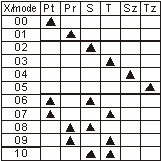| |
Q1: How to change the control mode of Delta servo drive?
A1: The users can use parameter P1-01 to change the control mode (see the following table). After the setting is completed, cut the power off and restart the servo drive again.
 |
Pt: Position control mode (command from external signal)
Pr: Position control mode (command from internal signal)
S: Speed control mode (external signal / internal signal)
T: Torque control mode (external signal / internal signal)
Sz: Zero speed / internal speed command
Tz: Zero torque / internal torque command
Q2: In Position Control mode, how many types of external pulse inputs?
A2: There are three types of external pulse inputs, including PULSE+SIGN, CW+CCW, 
Q3: What is the meaning of "Ratio of Load Inertia to Servo Motor Inertia"?
A3: Ratio of load inertia to servo motor inertia: (J_load /J_motor)
J_load: Load inertia
J_motor: Motor rotor inertia
When selecting the servo drives and motors that the user want to use, the user not only should consider the motor torque and rated speed, but also need to know the ratio of load inertia to servo motor inertia. Then, the user can select the proper motor that is correctly matched for the servo drive according to the actual requirements of the connected machine (load condition) operation and the quality and quantity requirements for materials processing and manufacturing. When perform tuning and trial run, setting (J_load /J_motor) correctly is the most important / essential for optimizing the performance of the mechanical system and servo system and make them work efficiently. Q4: What is stiffness?
A4: Stiffness is a measure of how well a servo motor can hold a position when some outside force is trying to move it. We can say it is a strength that is against the low frequency external force.
Q5: Why the ratio of load Inertia to servo motor inertia that is adjusted by the customer will be not the same as the actual ratio value?
A5:Maybe the following conditions are not met. When estimating the ratio of load Inertia to servo motor inertia, please satisfy the following conditions in order to ensure the correct ratio of load Inertia to servo motor inertia.
1) The accel. and decel. time for reaching 2000rpm should be 1sec. and below.
2) The rotation speed should be kept as 200rpm and above.
3) The load inertia cannot exceed 100-multiple of motor inertia.
4) The outside force cannot too much and the change of the ratio of load inertia to servo motor inertia cannot be excessive.
5) In AutoMode (when setting parameter P2-32 to 3 or 5), the system will stop to measure the load inertia value. Q6: What is regenerative resistor? How to connect a regenerative resistor? What kind of situation that needs to use the regenerative resistor?
A6:
1) When the output torque of servo motor in reverse direction of motor rotation speed, it indicates that there is a regenerative power returned from the load to the servo drive. This power will be transmitted into the capacitance of DC Bus and result in rising voltage. When the voltage has risen to some high voltage, the servo system needs to dissipate the extra energy by using a regenerative resistor.
2) Delta ASDA series servo drive provides a built-in regenerative resistor and the users also can connect to external regenerative resistor if more regenerative capacity is needed. When using an external regenerative resistor, connect it to P and C, and make sure the circuit between P and D is open. When using a built-in regenerative resistor, connect it to P and D, and ensure an open circuit between P and C.
3) When the regenerative power exceeds the processing capacity of the servo drive, the fault, ALE05 may occur. At this time, please install an external regenerative resistor.
|
|
